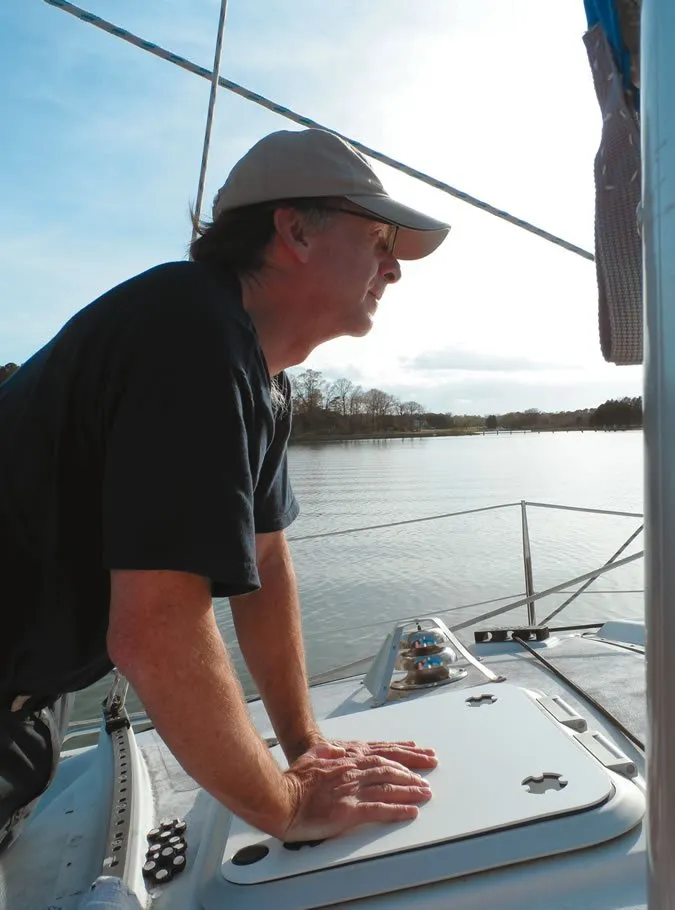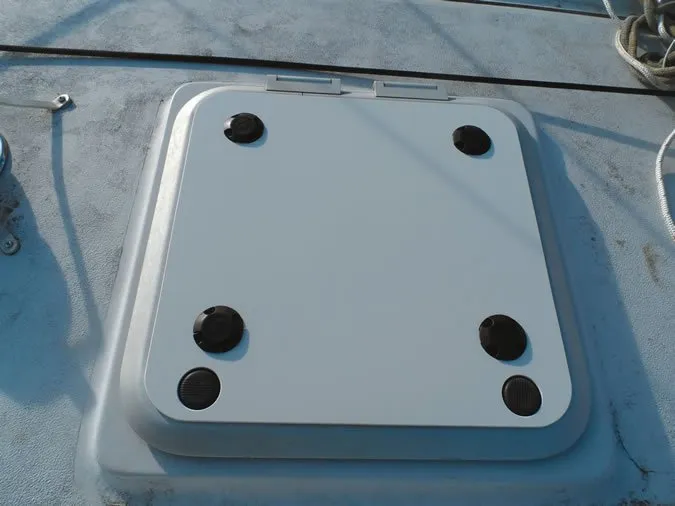Ultra-violet light is a relentless villain that destroys vinyl, gelcoat, paint, and lines, bit by bit. The best we can do is delay the inevitable for a season or two with regular maintenance chores like waxing and preventative measures like covering eisenglass or Lexan. Windows, both soft vinyl and the rigid polycarbonate or acrylic sort, are particularly vulnerable and expensive. To protect them, we use light-proof hatch covers, which reduce heat in the summer and provide insulation in the winter.
Hatch covers should be quick and easy to remove, easy to clean, and durable; and its a big plus if they remain in place underway and while the hatches are open. We recently came across an interesting product from Outland Hatch Covers (OHC) that looked like it would fit all of the criteria, so we decided to put a few samples through their paces on cabintop hatches aboard a PDQ 32.
The North Carolina-based company manufactures low-profile PVC covers that fit directly to the Lexan glass. The white PVC reflects ultraviolet light (UV) and is UV resistant. The cover even floats, if its dropped overboard.

Fitting and installation
Outland covers promise easy removal, a custom fit for even low-profile hatches, and ease of installation. While OHC can produce many covers from manufacturer data sheets, the maker recommends taking your own measurements using their guide and taking a few pictures to avoid any ambiguity. We did as they suggested, and the fit was spot-on; both covers fit well, right side up (there is no top) and inverted.
Fabricated from expanded PVC, they are attached with two or four patented, twist-locking, self-adhesive circles, or buttons; the number depends on size and whether external handles must be incorporated. (The covers can slide under external handles.)
Installation takes just a few minutes and is made easier by watching Outland Hatch Covers simple installation video on the OHC website. First, clean the lenses: Simply wash them with a solution of 1 tablespoon of dishwashing liquid in 5 cups of water; rinse and dry well. Press the buttons firmly into place using the cover as a guide. It takes three days for the buttons to reach peak strength, and warm, dry weather is recommended for those three days. Testers found the process-which was carried out at anchor-completely painless.

What We Found
OHC recommends that the hatches be removed for offshore sailing, but said that they can remain in place for coastal passages. We left ours in place for two years of sailing on Chesapeake Bay, through numerous squalls and some rough weather. Located near the foot of the mast, the covers we tested got stepped on a lot while we were handling sails. Occasionally, a cover lock was accidentally opened with the twisting motion of a shoe, but the covers were never damaged, never came off, and never even lifted a corner. We never caught a hatch covers corner with sheets or halyards, nor did we ever snag a line.
Testers noted that with the covers, the cabin was significantly cooler in the summer and warmer in the winter. We are very satisfied with the convenience they offered on hatches that had resisted all previous efforts with canvas covers.
The fixed windows on the test boat are fitted with snap-on canvas covers and the vinyl hardtop windows are covered either with snap-on covers or non-contact awnings; these offered a good comparison to the OHC covers. For the fixed windows-our wraparound view from the salon-we like our snap-on canvas covers because the attachment fittings are on the frame and do not obstruct the view. OHC covers cannot be applied to flexible vinyl windows, so canvas remains the standby, either snap-on for skylights or awnings for the front and side curtains. While the awnings must be removed underway, they do have the added advantage of deflecting rain. On the other hand, the OHC covers look slick and custom, shed dirt far better than canvas, add more insulation, and do not affect hatch operation. Thats a lot for us to like.
Bottom line
For appropriate hatches-and the range is wide-the Outland Hatch Covers offer a durable, attractive, easy, and trouble-free solution. We Recommend Outland Hatch Covers. Considering the cost of Lexan lens replacement due to UV damage, the covers (about $40 to $80 each) seem like smart money.
































